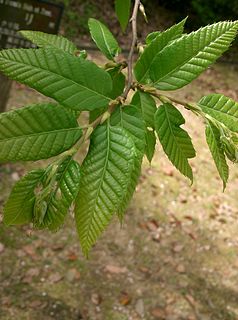
The chestnuts are a group of eight or nine species of deciduous trees and shrubs in the genus Castanea, in the beech family Fagaceae. They are native to temperate regions of the Northern Hemisphere.

Castanea is a census-designated place (CDP) in Castanea Township, Clinton County, Pennsylvania, United States. The population was 1,125 at the 2010 census.

The bay-breasted warbler is a New World warbler. It breeds in northern North America, specifically in Canada, into the Great Lakes region, and into northern New England.

Castanea sativa, or sweet chestnut, is a species of flowering plant in the family Fagaceae, native to Southern Europe and Asia Minor, and widely cultivated throughout the temperate world. A substantial, long-lived deciduous tree, it produces an edible seed, the chestnut, which has been used in cooking since ancient times.

The chestnut teal is a dabbling duck found in Australia. It is protected under the National Parks and Wildlife Act 1974.

Castanopsis, commonly called chinquapin or chinkapin, is a genus of evergreen trees belonging to the beech family, Fagaceae. The genus contains about 120 species, which are today restricted to tropical and subtropical eastern Asia. A total of 58 species are native to China, with 30 endemic; the other species occur further south, through Indochina to Indonesia, mountainous areas of Taiwan, and also in Japan. The English name chinkapin is shared with other related plants, including the golden chinkapins of the Pacific United States, which are sometimes included within Castanopsis but are more often considered a separate but very closely related genus, Chrysolepis.

Castanea crenata, known as Korean chestnut, Korean castanea, and Japanese chestnut, is a species of chestnut originally native to Japan and South Korea. It is a small to medium-sized deciduous tree growing to 10–15 m tall. The leaves are similar to those of the sweet chestnut, though usually a little smaller, 8–19 cm long and 3–5 cm broad. The flowers of both sexes are borne in 7–20 cm long, upright catkins, the male flowers in the upper part and female flowers in the lower part. They appear in summer, and by autumn, the female flowers develop into spiny cupules containing 3–7 brownish nuts that are shed during October.

The chestnut short-tailed bat is a bat species from South and Central America.

The chestnut wattle-eye is a species of bird in the family Platysteiridae. It is found in Angola, Cameroon, Central African Republic, Republic of the Congo, Democratic Republic of the Congo, Equatorial Guinea, Gabon, Kenya, Nigeria, South Sudan, Tanzania, Uganda, and Zambia. Its natural habitats are subtropical or tropical moist lowland forest, subtropical or tropical swamps, and moist savanna.

Earl Lemley Core was a botanist and botanical educator, researcher, and author as well as a local West Virginia historian. He was founder of the Southern Appalachian Botanical Club and editor of its journal, Castanea, for thirty-five years. He was a teacher and professor at West Virginia University (WVU) from 1928 to 1972. He served for four years on the Morgantown City Council, and served as mayor of Morgantown for two years. The Earl L. Core Arboretum at WVU was named in his honor in 1967.

Cydia amplana, the rusty oak moth, is a moth of the family Tortricidae. It is found from central and southern Europe to Asia Minor, south-western Russia and Transcaucasus.
Calliini is a tribe of longhorn beetles of the Lamiinae subfamily.
Euryestola is a genus of longhorn beetles of the subfamily Lamiinae.
Euryestola caraca is a species of beetle in the family Cerambycidae. It was described by Galileo and Martins in 1997. It is known from Brazil.
Euryestola iquira is a species of beetle in the family Cerambycidae. It was described by Galileo and Martins in 1997. It is known from Colombia and Ecuador.
Euryestola morotinga is a species of beetle in the family Cerambycidae. It was described by Galileo and Martins in 1997. It is endemic to Brazil.
Euryestola murupe is a species of beetle in the family Cerambycidae. It was described by Galileo and Martins in 1997. It is endemic to Venezuela.
Euryestola antennalis is a species of beetle in the family Cerambycidae. It was described by Breuning in 1940. It is known from Venezuela and Brazil.
Euryestola freyi is a species of beetle in the family Cerambycidae. It was described by Breuning in 1955. It is known from Trinidad and Tobago.












